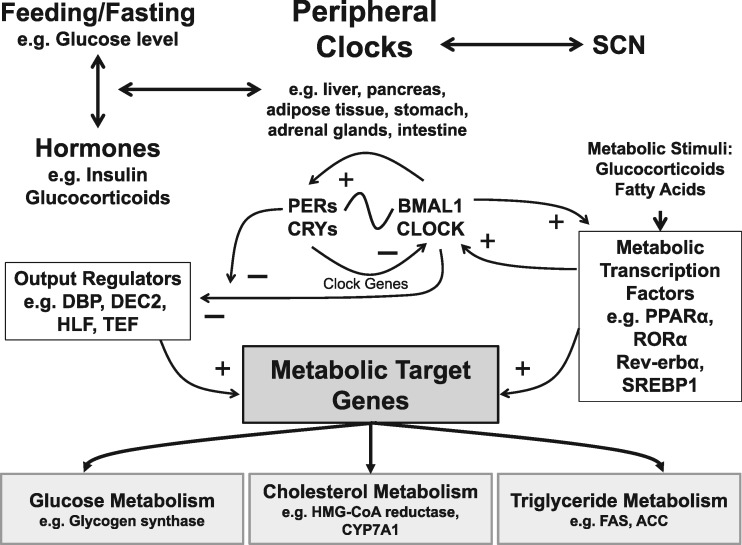Figure 3.
The circadian control of metabolic pathways. Metabolism is under strong circadian control. Peripheral clocks (e.g. liver, pancreas, adipose tissue, etc.) are regulated by the SCN and in turn feedback upon the SCN. Light regulates the phase of the molecular clockwork in the SCN, whilst hormonal signals (e.g. insulin and glucocorticoids) and feeding/fasting behaviours that change the levels of glucose alter the phase of peripheral clocks. The molecular clockwork of both peripheral and SCN cells then interacts with the metabolic control systems. The molecular clock comprises a Per/Cry and Clock/Bmal1 feedback loop (See Figure 1). These genes and their protein products also control the expression of downstream transcription factors which in turn regulate metabolic target genes. General regulators include DBP (D site of albumin promoter (albumin D-box) binding protein), which binds to an upstream promoter in the insulin gene; HLF (Hepatic leukaemia factor), which regulates aspects of liver function; and TEF (Thyrotroph embryonic factor), involved in thyroid-stimulating hormone release. The circadian coordination of metabolism also involves members of the rev-erb (REV-ERB) receptor family, retinoic acid orphan receptors (ROR), PPARs (peroxisome proliferator-activated receptors) and other nuclear receptors (NR). Metabolic regulators, such as REV-ERBα and ROR, also participate directly in the clock mechanism by regulating Bmal1 transcription (See Figure 1). In addition, hepatic PPARα, which is activated by fatty acids, is regulated rhythmically by CLOCK and BMAL1 and is also regulated by glucocorticoids. These transcriptional regulators in-turn interact with genes associated with glycogen, fatty acid and triglyceride metabolism. Such target genes include: Glycogen synthase, involved in converting glucose to glycogen; HMG-CoA reductase which is the rate-controlling enzyme that produces cholesterol; CYP7A1 is a rate-limiting enzyme in bile acid synthesis; Acetyl-CoA carboxylase (ACC) and Fatty acid synthase (FAS) are involved in catalysing the synthesis of fatty acids. This regulation can be immensely complex, with multiple interlocking feedback loops between the clock and metabolic genes/proteins. For example, transcriptional regulation of rhythmic CYP7A1, is driven by DBP, the clock protein DEC2, and by nuclear receptors including PPARα. PPARα also regulates Rev-erbα expression in both liver and adipose cells, whilst ROR and Rev-erbα regulate lipid metabolism as well as being involved in Clock and Bmal1 expression.

